Usually, when I go to a high-end Japanese restaurant, I get pulled in a variety of directions while deciding what to order. Of course, Japanese cuisine is most famously known for their raw fish delicacies - sashimi and sushi. Besides the fresh fish, they are also famous for beef - Kobe, Yonezawa, and Matsusaka beef - and pork - Kurobuta. In each of these cases, the food is generally prepared simply and elegantly with much of the emphasis on the quality of the ingredients. So what should I order? Well, it depends on what ingredients the restaurant happens to be carrying.
On the evening that we visited Uchi, the daily specials menu was quite varied ranging from rabbit to whole grilled sea bass to Wagyu ribeye. Wagyu is the breed of cattle that is most famously employed in Kobe beef, but not all Wagyu beef (and not all Kobe beef) is up to the quality level of the beef of legend that seems to be all the rage these days. (The best beef I've ever had is still the Yonezawa beef I had in Yonezawa, Japan.)
 A regular item on the menu that caught my eye was the kurobuta pork belly. Tina and I routinely lament the mild flavor of pork. Here, in the United States, hogs have been bred to be extremely lean (to the point where the pork industry marketed their pork products as "the other white meat"). This was good for business since many Americans know that they aren't living healthy lives and try to compensate by eating foods that they believe are healthy - like lean pork. Unfortunately, this came at a cost - the reduced fat meant reduced flavor. (Sometimes, I can't tell the difference between stir fry dishes using chicken breast and those using pork loin - they just taste like chewy protein. I think that's pretty sad since pork has a very nice natural flavor.) Enter the Japanese and their Kurobuta pork. Kurobuta (which means "black hog") pork comes from a variety of hog known as the Berkshire. Since the Berkshire breed has been preserved in Japan (and other nations), it's one of the few ways to get pork in the U.S. that is still full flavored and marbled with fat. Tina and I find the taste difference between regular pork and Kurobuta/Berkshire pork to be so great that we almost always order Kurobuta pork when we see it on the menu.
A regular item on the menu that caught my eye was the kurobuta pork belly. Tina and I routinely lament the mild flavor of pork. Here, in the United States, hogs have been bred to be extremely lean (to the point where the pork industry marketed their pork products as "the other white meat"). This was good for business since many Americans know that they aren't living healthy lives and try to compensate by eating foods that they believe are healthy - like lean pork. Unfortunately, this came at a cost - the reduced fat meant reduced flavor. (Sometimes, I can't tell the difference between stir fry dishes using chicken breast and those using pork loin - they just taste like chewy protein. I think that's pretty sad since pork has a very nice natural flavor.) Enter the Japanese and their Kurobuta pork. Kurobuta (which means "black hog") pork comes from a variety of hog known as the Berkshire. Since the Berkshire breed has been preserved in Japan (and other nations), it's one of the few ways to get pork in the U.S. that is still full flavored and marbled with fat. Tina and I find the taste difference between regular pork and Kurobuta/Berkshire pork to be so great that we almost always order Kurobuta pork when we see it on the menu.To top it off, we learned that the fish served at Uchi is flown in from the Tsukiji fish market (the worlds largest daily fish market where the freshest and highest quality fish are auctioned every morning). So what do we do when we need to try everything? Omakase - we let the chef and our server, Erin, arrange a meal for us. The term omakase literally means to "entrust" and that's very much what we did. Since we had never dined at Uchi before, I didn't leave it completely up to chance - I explained to Erin my personal weakness for otoro (the highest quality cut from the belly of a bluefin tuna - when the fish is good and properly cut, it has a buttery consistency and feels like it melts in your mouth) and our interest in the Kurobuta pork. Erin asked us if we had any food restrictions or food allergies, and I reassured her that had we had any allergies, we'd still eat the food and suffer the consequences.
Armed with that information, Erin put together our amazing meal and we started to dine.
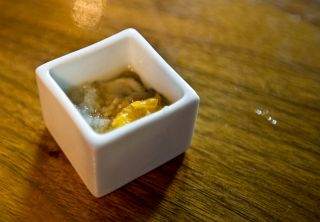
amuse bouche
We started with an amuse served in a tiny cup containing a Winterpoint oyster with yuzu san bai zu (sweet vinegar sauce) and minced daikon & ginger. The oyster was super fresh - yielding a sweet and not at all fishy taste. The mild ginger and sweet citrus vinegar made this a perfectly balanced amuse bouche and really got us excited about the possibilities of the upcoming dishes.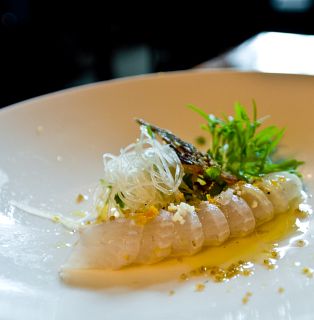
hirame usuzukuri
thinly-sliced flounder, spanish olive oil, smoked sea salt, yuzu zest, daikon, crispy quinoa ($18)
The raw flounder was extremely fresh resulting in an light, delicate flavor, almost as if it was intended as a vehicle for the other ingredients (which included microbasil and microfennel). Eating all the ingredients together in the same bite was a delight when the flavors intermingled. But, when I focused, I could taste the herbaceousness of the olive oil, the mild spice of the daikon and microgreens, and the citrus of the yuzu. Keep in mind that all of these flavors were subtle, so the flavors of the dish were perfectly matched with the flounder.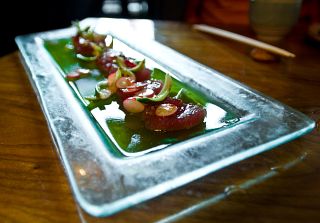
tombo nasu
hawaiian albacore, thai eggplant, lemongrass vinaigrette, breakfast radish, sweet chili gastrique, cucumber ($19)
This was the best course we had in this amazing dinner. It's Hawaiian albacore tuna topped with chili and lemongrass sauce served with shaved radish and crunchy thai eggplant slivers on top of a bed of sweet cucumber gelatin. The flavors and textures were working overtime on this one. Sweetness: sweet chili sauce with the natural mild sweetness of fresh tuna, highlighted by the slight citrus-acidity of the lemongrass, and the refreshing sweetness of the cucumber gelatin. Spiciness: chili sauce, radish, and fresh eggplant. Texture: crunchy eggplant slivers and radish shavings, meaty tuna, and melt-in-the-mouth gelatin. The most amazing part is that all of these different traits worked perfectly together resulting in a warming and refreshing feel as you eat it. Unfortunately, this dish does not seem to be a regular item (it's part of their nightly specials), but if you see it, make sure you order it.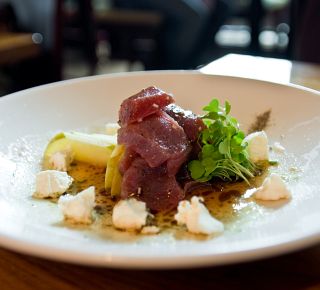
maguro sashimi and goat cheese
with cracked pepper, fuji apple, and pumpkin seed oil ($17)
This was another course that we thought was extremely impressive. Luckily, it is on the permanent menu, I'd recommend ordering this dish on your visit. We ate this dish by layering the bigeye tuna with goat cheese onto a slice of fuji apple and eating the bite-sized stack whole. The combination of flavors (sweet and acidic apple, bitter and astringent microgreens, creamy and earthy Texas goat cheese, and spicy and biting black pepper) activated all the taste buds simultaneously. Like the previous dish, this was simply amazing and was definitely a new taste experience.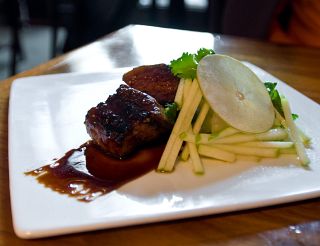
bacon steakie
twice-cooked kurobuta pork belly with green apple ($12)
The pork belly, braised then grilled, was served with an extremely flavorful sweet Indonesian soy sauce with a salad of green apple, onions, and parsley with a citrus oil. The pork was succulent and crispy, and overall the dish was very good. Excellent taste and texture, but not as amazing or world changing as the last two dishes.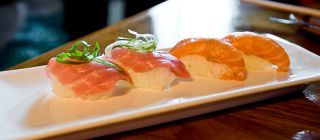
super toro bluefin belly ($18) and sake fresh atlantic salmon ($6) nigiri
Nigiri is probably the prime example of how simple Japanese cuisine can be and yet how amazingly flavorful, satisfying, and elegant it is when properly done. There are only really three ingredients so they must be of highest quality and properly portioned (especially if the wasabi is served as part of the nigiri and not made into a self applied paste with soy sauce as is the Western custom). Both the sake (salmon) and otoro (bluefin tuna belly) were extremely fresh, having no fishy taste whatsoever. They were naturally savory with a delicate sweetness and a buttery texture. The rice was warm with distinct grains (with a little bit of chew - almost like it was al dente pasta), and seasoned lightly with the most delicious vinegar. There is no doubt that the sushi at Uchi is top notch. Plus, it's always a pleasure eating otoro.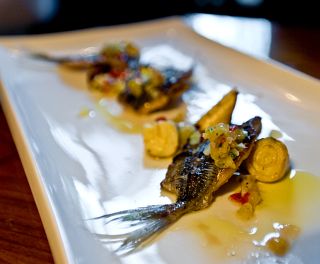
mame aji
grilled baby blue mackerels, hearts of palm, tomato relish, sherry vinegar ($16)
The baby mackerels, which had crispy skin and tender flesh, were heavily salted, but, after the initial burst of saltiness, chewing on the flesh with the hearts of palm mellowed out the flavor. This dish had a very intense and assertive taste which contrasted with the earlier fish courses. Very tasty.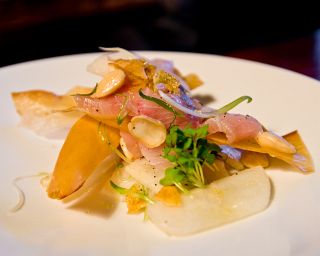
hamachi cure
sugar-cured maplewood-smoked baby yellowtail, yucca crisps, asian pear, garlic brittle ($18)
The hamachi or Japanese amberjack was sweet with a mild smokiness and this paired well with the other sweet to mildly sweet ingredients - gold currants, candied garlic, asian pears, marcona almonds, and yucca chips. We placed each of the ingredients on a yucca chip and ate it like that allowing the yucca to provide crunchiness while enjoying the various sweet ingredients.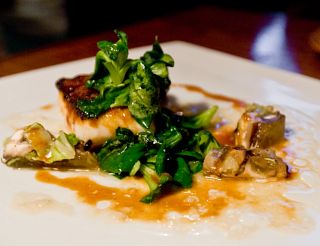
mero sake
caramelized mero bass, sake lees, shiitake terrine, arugula mâche ($22)
The Hawaiian Mero bass "caramelized with miso" was tender and flavorful - meaty but in a falling apart and juicy way. The terrine, made with shiitake mushrooms, napa cabbage, and gelatin, was strongly flavored and along with the vinaigrette of sake lees served as a perfect counterpoint to the bass.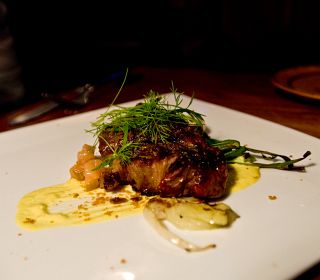
wagyu tamago
cherry-wood smoked wagyu ribeye, quince jam, fried egg purée, bottarga, grilled fennel ($34)
The ribeye steak was served rare topped with fennel and fennel greens. A sweet, tart quince jam was paired with the steak along with some ramps and a sauce made of pureed fried egg. The flavor of the ribeye was subtle with the faint cherry wood smoke being the dominant tone. Although there was some gristle in the beef, on the whole it was exquisite. I commented that this course was the perfect "bookend" to the meal which began with raw fish and, now, had a finale of nearly raw beef - both subtle in flavors, similar in texture, and elegantly prepared.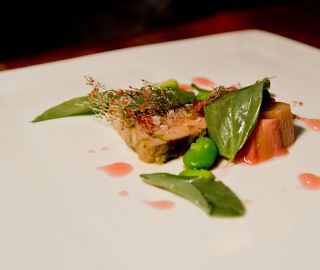
raisei foie
seared foie gras terrine, rhubarb pavé, fava bean, pink peppercorn ($20)
I thought the Wagyu beef course was going to be our last before dessert, but Erin asked if we'd like to have a coarse of foie gras before our dessert and while I was deciding on if I had enough space left, Tina answered for me (working on the assumption and experience that I never turn down foie gras). So, a foie course appeared and I realized that I had reached the point where I was pretty much out of words and could not describe anything anymore. The cold foie gras terrine was excellent, but, unlike the other complex dishes we had earlier, I didn't care for eating it simultaneously with it's accompaniments - the rhubarb and rhubarb gelatin. The gelatin was sweet and fruity while the rhubarb itself was fairly tart. I found that alternating between the foie and the rubarb was good, and I suspect it refreshed the palate between bites of the foie gras... Unfortunately, my ability to provide feedback on food seemed to be limited at this point in the meal.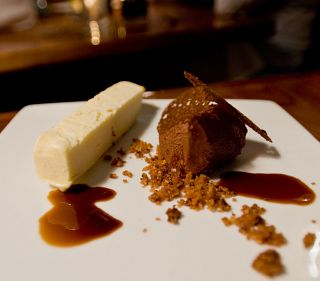
dark chocolate terrine, meyer lemon gelato, pecan nougatine, coffee caramel ($9)
The terrine (made with Valrhona chocolate) had a velvety texture that worked perfectly with the nougatine (a brown nougat made with pecans). The gelato was also velvety in texture but was refreshingly lemony but not acidic. A great end to an excellent meal.The reason why I consider this meal to be the best I've ever had is that, with this many courses, it was exceptional to have them all rate in the good to excellent range (with a couple so exceptional that they truly introduced us to new flavor and texture combinations). In the past, we've had excellent multi-course meals but there have always been at least one or two courses that could have used improvement. At Uchi's this was not the case; the execution was pretty much flawless.
Not only was the food excellent, our server, Erin McReynolds, was the best captain we’ve ever had at any restaurant. Besides being friendly and personable, she really knew her food, was articulate and patient when I needed ingredients or explanations repeated, and was genuinely excited that Tina and I were excited about our food. I don't know if all the staff is at the level of Erin (and I suspect they are not), but we were blessed and lucky to have her waiting on us and it certainly helped make the incredible 3-1/2 hour dinner even better.